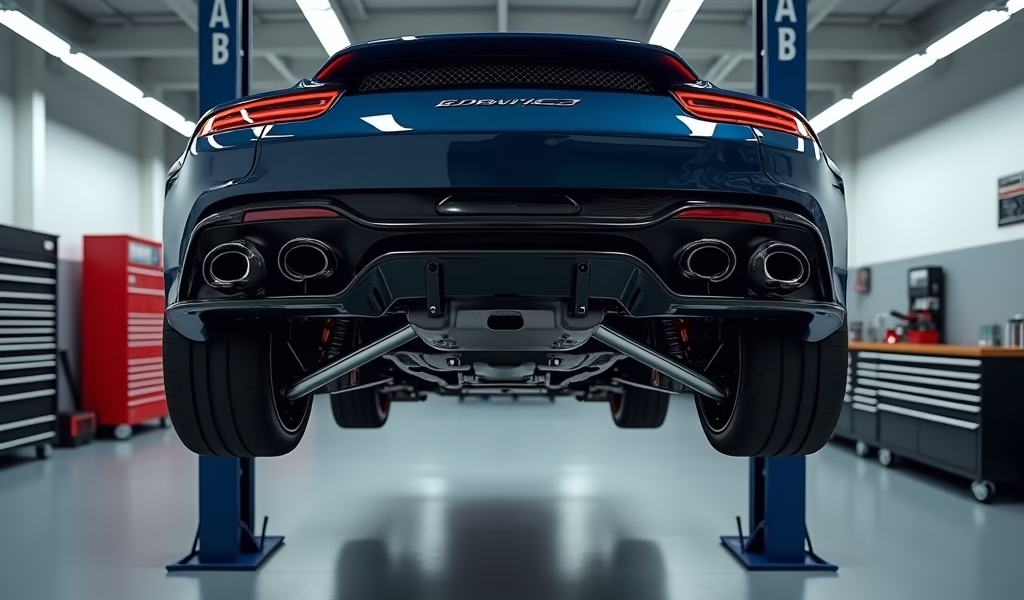Overview
This article explains how to calculate the ideal anti-roll bar diameter for vehicles, emphasizing that proper sizing depends on vehicle weight, center of gravity, intended use, and suspension geometry, with diameter affecting stiffness exponentially (to the fourth power). It provides mathematical formulas, real-world examples, and tuning guidance while debunking the “stiffer is better” myth, stressing that anti-roll bars should be viewed as part of a complete suspension system that balances handling precision with ride quality.
Table of Contents
- Understanding Anti-Roll Bars
- Why Diameter Matters
- Factors Affecting Anti-Roll Bar Selection
- The Mathematics Behind the Calculation
- Step-by-Step Calculation Guide
- Real-World Examples
- Fine-Tuning Your Setup
- Common Mistakes to Avoid
- Conclusion
- Frequently Asked Questions
Understanding Anti-Roll Bars
Ever noticed how some cars seem to stay perfectly flat when cornering while others lean like they’re about to tip over? That’s where anti-roll bars come into play. As a mechanic who’s spent countless hours underneath vehicles of all types, I can tell you these simple-looking bars are engineering marvels that dramatically transform how your car handles.
Anti-roll bars (also called sway bars or stabilizer bars) connect the left and right sides of your suspension. They’re essentially torsion springs that resist body roll during cornering. When you take a turn, centrifugal force pushes your vehicle’s weight to the outside, causing it to lean. This leaning transfers more weight to the outside wheels and lifts weight from the inside wheels, potentially reducing overall grip.
A properly sized anti-roll bar helps distribute that cornering force more evenly across all four tires. It keeps your car flatter through turns, improves responsiveness, and gives you that planted feeling that inspires confidence. But here’s the catch – there’s no one-size-fits-all solution. The perfect anti-roll bar diameter depends on your specific vehicle, driving style, and goals.
Why Diameter Matters
Let’s talk about why diameter is so crucial when it comes to anti-roll bars. The thickness of the bar directly affects its stiffness, which determines how much it resists twisting during cornering. This relationship isn’t linear – it’s exponential. In fact, the stiffness of a solid round bar increases with the fourth power of its diameter.
What does that mean in practical terms? If you increase the diameter by just 10%, the bar becomes about 46% stiffer. Double the diameter, and you get a bar that’s 16 times stiffer! This exponential relationship makes diameter selection incredibly sensitive – even small changes can dramatically alter your vehicle’s handling characteristics.
I’ve seen countless customers chase handling problems by installing the stiffest bars they can find, only to create new issues. A bar that’s too stiff can actually reduce grip by lifting inside wheels off the ground during hard cornering. Conversely, a bar that’s too soft won’t provide enough roll resistance, leading to excessive body lean and slow transitional response.

Factors Affecting Anti-Roll Bar Selection
Before diving into calculations, you need to understand the various factors that influence anti-roll bar selection. I’ve worked on everything from family sedans to dedicated track cars, and the approach varies significantly based on these key factors:
Vehicle Weight and Distribution
Heavier vehicles generally need stiffer anti-roll bars to control body motion. A 4,000-pound SUV requires much more roll resistance than a 2,500-pound sports car. Weight distribution matters too – a front-heavy car might need a proportionally stiffer front bar to balance handling characteristics.
Vehicles with double wishbone suspension geometry often handle weight transfer differently than those with MacPherson struts, which affects your anti-roll bar calculations.
Center of Gravity Height
The higher your vehicle’s center of gravity, the more leverage it has to create body roll. SUVs and trucks typically need stiffer bars than sports cars with the same weight because their mass is concentrated higher off the ground. This is why performance SUVs often feature anti-roll bars that would seem excessive on a lower-riding vehicle.
Intended Use
This might be the most important consideration. What are you trying to achieve?
- Daily driver: You’ll want balanced handling with good ride quality
- Autocross/track car: Maximum cornering grip and rapid transitions are priorities
- Off-road vehicle: You may need adjustable or disconnectable bars for articulation
- Towing: Stability under varying loads becomes critical
Your goals should guide your entire approach to anti-roll bar diameter calculation. As research from the Society of Automotive Engineers shows, there’s always a trade-off between handling precision and ride comfort when adjusting roll stiffness.
Suspension Geometry
The design of your suspension significantly impacts how anti-roll bars function. Key factors include:
- Mounting points and leverage ratios
- Motion ratios through suspension travel
- Arm lengths and attachment methods
- Existing spring rates and damper settings
When selecting coilover spring rate selections, you’ll need to consider how they work with your anti-roll bars as part of a complete suspension package.
The Mathematics Behind the Calculation
Now let’s get into the nitty-gritty of calculating the ideal anti-roll bar diameter. Don’t worry if math isn’t your strong suit – I’ll break this down into digestible pieces.
The basic formula for calculating the torsional stiffness of a solid round bar is:
K = (G × J) / L
Where:
- K = torsional stiffness (Nm/radian)
- G = shear modulus of the material (usually around 80 GPa for steel)
- J = polar moment of inertia
- L = effective length of the bar
For a solid circular bar, the polar moment of inertia (J) is calculated as:
J = (π × d⁴) / 32
Where d is the diameter of the bar in meters.
When we combine these equations and solve for diameter, we get:
d = ⁴√(32 × K × L / (G × π))
This is where that fourth-power relationship becomes evident. The material you choose also matters. Most anti-roll bars are made from spring steel, but different alloys have different properties. Chrome-molybdenum steel (4130) is popular for performance applications due to its excellent strength-to-weight ratio.
In practical applications, we need to factor in the roll moment arm (the effective lever that transfers force from the wheel to the bar) and the desired roll stiffness (how much the vehicle should resist leaning in corners).
Step-by-Step Calculation Guide
Let me walk you through how I approach anti-roll bar diameter calculation for my customers:
Step 1: Determine Your Target Roll Stiffness
Start by deciding how much roll resistance you want. This depends on your vehicle and goals, but here are some general ranges:
- Comfort-oriented daily driver: 500-800 Nm/degree
- Sport-oriented street car: 800-1200 Nm/degree
- Track/competition car: 1200-2000+ Nm/degree
Remember, this is total roll stiffness – your springs already contribute to this value.
Step 2: Calculate Spring Contribution
Your springs already provide roll resistance. To find this value:
Spring Roll Stiffness = (Front Spring Rate × Front Track Width²) / 2 + (Rear Spring Rate × Rear Track Width²) / 2
The anti-roll bars need to provide the difference between your target roll stiffness and what the springs provide.
Step 3: Determine Front/Rear Distribution
Decide how to distribute roll stiffness between front and rear. This affects whether your car tends toward understeer (pushing wide in corners) or oversteer (rear end stepping out). For most street cars, a slight understeer bias is safest, while track cars might benefit from more neutral handling.
Step 4: Calculate Required Bar Stiffness
Convert your desired roll resistance into the actual torsional stiffness required from the bar itself, accounting for the suspension leverage ratio:
Bar Torsional Stiffness = Roll Stiffness Contribution / (2 × Motion Ratio² × Lever Arm²)
Step 5: Calculate Diameter
Now you can use our diameter formula:
d = ⁴√(32 × K × L / (G × π))
Where:
- d = diameter in meters
- K = required torsional stiffness from Step 4
- L = effective length of the bar in meters
- G = shear modulus of your chosen material
Similar to torsion bar adjustment procedures, getting the calculations right is critical for achieving the desired performance.
Remember that research on vehicle roll stability shows that properly calculated anti-roll bars can improve handling without sacrificing ride quality when properly matched to the vehicle’s other suspension components.

Real-World Examples
Let’s put these formulas to work with some real-world examples I’ve encountered in my shop:
Example 1: Daily Driver Sedan
For a 3,200-pound (1,450 kg) front-wheel-drive sedan looking for improved handling without sacrificing comfort:
- Target roll stiffness: 700 Nm/degree
- Spring contribution: 450 Nm/degree
- Anti-roll bar contribution needed: 250 Nm/degree
- Front/rear distribution: 65%/35%
- Front bar contribution: 162.5 Nm/degree
After factoring in the leverage ratios (2:1) and effective length (0.8m), we calculated a front bar diameter of approximately 19mm. This provided noticeably improved cornering with minimal impact on ride quality – exactly what the customer wanted.
Example 2: Track-Day Sports Car
For a 2,900-pound (1,315 kg) rear-wheel-drive sports car being prepared for occasional track use:
- Target roll stiffness: 1,400 Nm/degree
- Spring contribution: 600 Nm/degree
- Anti-roll bar contribution needed: 800 Nm/degree
- Front/rear distribution: 55%/45%
- Front bar contribution: 440 Nm/degree
With leverage ratios of 2.5:1 and effective length of 0.75m, we calculated a front bar diameter of 23.5mm. This provided the flat cornering and responsive transitions needed for track work while maintaining enough compliance for street driving.
Example 3: Off-Road SUV
For a 4,500-pound (2,040 kg) 4×4 SUV used both on-road and for moderate off-roading:
- Target on-road roll stiffness: 950 Nm/degree
- Spring contribution: 400 Nm/degree
- Anti-roll bar contribution needed: 550 Nm/degree
- Front/rear distribution: 60%/40%
We recommended a disconnectable front bar system with a diameter of 30mm. This provided good on-road stability for the tall vehicle but could be disconnected for improved articulation on trails.
Fine-Tuning Your Setup
The calculations get you in the ballpark, but real-world testing is essential for perfection. Here’s how I help my customers fine-tune their setups:
Adjustable Bars
If possible, start with adjustable anti-roll bars. These have multiple mounting holes for the end links, allowing you to change the effective stiffness without replacing the entire bar. This makes fine-tuning much easier and less expensive.
Testing Methodology
Use structured testing to evaluate handling objectively:
- Slalom: Tests transitional response and weight transfer
- Skidpad: Evaluates steady-state cornering balance
- Varied corners: Tests real-world behavior in different scenarios
Make one change at a time and thoroughly test before moving on. Keep detailed notes about how each adjustment affects handling.
Balancing Front and Rear
The key to predictable handling is the balance between front and rear roll stiffness:
- Increasing front roll stiffness promotes understeer
- Increasing rear roll stiffness promotes oversteer
- The ideal balance creates neutral handling that responds predictably to driver inputs
Most street cars benefit from a slight understeer bias for safety, while competition vehicles might want more neutral or even slightly oversteering setups for quicker rotation.
According to vehicle dynamics research, the front-to-rear roll stiffness distribution is often more important than the absolute stiffness values for achieving balanced handling.
Common Mistakes to Avoid
Over my years in the shop, I’ve seen folks make the same mistakes over and over when selecting anti-roll bars:
The “Stiffer is Better” Myth
The most common mistake is assuming maximum stiffness equals maximum performance. Excessively stiff bars can:
- Lift inside wheels, reducing overall grip
- Create harsh ride quality that’s unbearable on the street
- Cause unpredictable breakaway characteristics at the limit
- Overstress mounting points and bushings
Your goal should be optimal performance, not maximum stiffness.
Ignoring the Complete Package
Anti-roll bars work as part of a system. I often see customers install aggressive bars without considering:
- Spring rates and their contribution to roll resistance
- Damper settings that control weight transfer rates
- Bushing compliance that affects how the bar actually performs
- Alignment settings that influence how grip is generated
The most effective approach treats suspension tuning holistically, with anti-roll bars as just one piece of the puzzle.
Copying Someone Else’s Setup
Just because a certain diameter works perfectly on your buddy’s car doesn’t mean it’s right for yours. Even identical-looking vehicles can have different:
- Weight distributions
- Center of gravity heights
- Spring rates and damper settings
- Driver preferences and skill levels
Your anti-roll bar diameter calculation should be specific to your particular situation.
Conclusion
Calculating the perfect anti-roll bar diameter isn’t just about plugging numbers into formulas – it’s about understanding the delicate balance of forces that affect your vehicle’s handling. A properly sized anti-roll bar transforms not just how your car corners, but how connected you feel to the road.
I’ve seen countless vehicles go from wallowing disappointments to precision instruments with nothing more than properly calculated anti-roll bars. The beauty of this modification is its elegant simplicity – a relatively straightforward part that yields profound handling improvements when correctly sized.
Remember that the perfect anti-roll bar diameter is the one that makes your car respond exactly how you want it to. The calculations get you close, but your feedback and preferences make it perfect. Whether you’re building a canyon carver, a track day hero, or just want your family SUV to feel more planted on highway ramps, taking the time to properly calculate your anti-roll bar diameter pays dividends in driving enjoyment.
And isn’t that why we’re all here? To enjoy the drive, feel connected to our vehicles, and experience the satisfaction of a car that handles exactly the way we want it to. That’s the real magic of getting your anti-roll bar diameter just right.
Frequently Asked Questions
How does anti-roll bar diameter affect handling?
Larger diameter bars increase roll stiffness exponentially (by the fourth power), reducing body lean in corners. This improves handling response and weight distribution across all four tires during cornering.
Can I install different sized anti-roll bars front and rear?
Yes, and it’s actually recommended to have different sizes to achieve the desired handling balance. Front-to-rear anti-roll bar stiffness ratio determines whether your vehicle tends toward understeer or oversteer.
How do I know if my anti-roll bar is too stiff?
Signs include a harsh ride, inside wheels lifting during hard cornering, and skittish behavior on uneven surfaces. You might also notice reduced overall grip despite less body roll.
Are hollow anti-roll bars better than solid ones?
Hollow bars offer better stiffness-to-weight ratios but are more expensive and sometimes less durable. For a given stiffness, a properly sized hollow bar will be lighter than its solid equivalent.
Do I need to adjust other suspension components when changing anti-roll bars?
Yes, anti-roll bars work as part of your complete suspension system. You should consider spring rates, damper settings, and alignment when making changes to ensure balanced handling.

